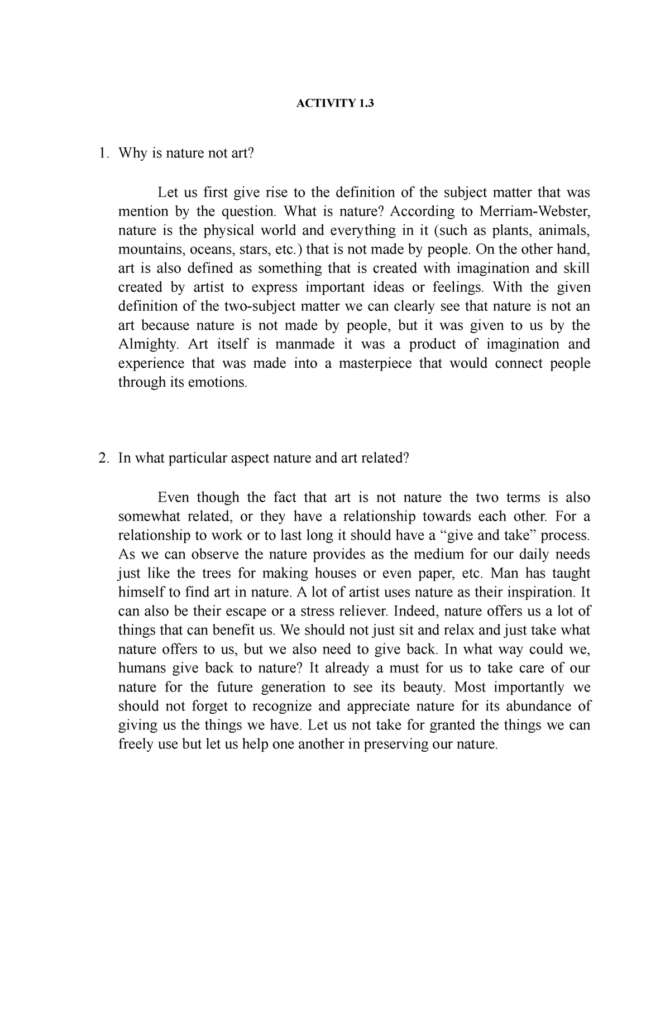The article titled “Why Art is Not Nature” explores the ongoing debate surrounding the distinction between art and nature. While some argue that anything created by humans can be considered art, others contend that art can only be found in the natural world. The article delves into the definitions of art and nature, highlighting the key differences between the two. It emphasizes that art is the result of an artist’s imagination and creative expression, while nature is the physical world and everything within it that is not made by humans. By exploring these distinctions, the article aims to provide readers with a clearer understanding of the differences between art and nature.
Why Art is Not Nature
Art and nature are two concepts that have often been intertwined in discussions and debates. While some may argue that anything created by humans can be considered art, others believe that art is distinct from nature. In this article, we will explore the definition of art and nature, discuss how to differentiate between the two, and provide our own thoughts on the matter.
What is Art?
Art is often described as the expression or creative application of human skill and imagination. It can take various forms such as painting, sculpture, music, poetry, and drama. While visual art forms like paintings and sculptures are commonly associated with art, it is important to note that art can be found in many other mediums and creations. Essentially, anything that has been created by humans can potentially be considered art.
What is Nature?
Nature, on the other hand, refers to the physical world and everything in it that is not made by humans. It encompasses all living things, such as plants and animals, as well as non-living things like rocks and water. Nature is comprised of natural formations and phenomena that have existed long before humans and will continue to exist long after we are gone.
How to Tell if It’s Nature or Art
Differentiating between nature and art can sometimes be challenging, especially when it comes to certain objects or formations. Here are some questions to consider when determining whether something is nature or art:
-
Is the object man-made? If the object has been created by humans, it is more likely to be art rather than nature.
-
Was the object created with the intent of being art? If an object has been intentionally crafted or designed as a work of art, it is more likely to be considered art rather than an element of nature.
-
Does the object exist in the natural world? Nature encompasses everything that exists in the world without human intervention. If the object is found naturally without any human involvement, it is more likely to be considered as part of nature.
-
Has the object been modified by humans? If an object found in nature has been altered or modified by humans, it can be seen as a combination of nature and art.
Considering these questions can help in determining whether something falls under the category of art or nature. However, it is important to remember that the distinction may not always be clear-cut, and personal interpretations can vary.
The Definition of Art
Art is characterized by the expression of human skill and imagination. It encompasses visual forms such as paintings and sculptures, but it extends far beyond those mediums. Music, poetry, literature, theater, and dance are all different forms of art that allow individuals to creatively express themselves and evoke emotions in others. Art provides a means of communication and storytelling, allowing artists to convey their ideas, thoughts, and experiences to an audience.
The Definition of Nature
Nature refers to the physical world and all the living and non-living things that exist within it. It includes the vast array of plants, animals, landscapes, and natural phenomena that have developed and evolved over millions of years. From the majestic mountains to the delicate flowers, nature’s beauty and complexity are awe-inspiring. Natural wonders, such as waterfalls, canyons, and caves, showcase the power and creativity of the natural world.

Art as a Product of the Imagination
One of the reasons art is distinct from nature is that it is a product of human imagination. Artists use their creativity and skill to conceptualize and bring to life something new and unique. Whether it’s a painting, a piece of music, or a poem, art is the manifestation of an artist’s ideas, emotions, and perspectives. Without the artist’s imagination and intention, art cannot exist.
The Timeless Existence of Nature
Nature, on the other hand, has existed since the beginning of time and will continue to exist long after humans are gone. It is not dependent on human creation or perception. The beauty of nature lies in its timeless existence and the balance and harmony it maintains. From the changing seasons to the cycle of life and death, nature has its own rhythm and flow. It is a reminder of the vastness and interconnectedness of the world we inhabit.

Determining if It’s Art or Nature
Determining whether something is art or nature can be a subjective process. However, considering certain factors can help in making a distinction:
-
Examining man-made objects: If an object has clear signs of human craftsmanship or design, it is more likely to be considered art rather than a natural element.
-
Exploring the natural world: If an object is found in a natural environment without any human intervention, it can be seen as a part of nature.
-
Differentiating between natural and human modifications: If an object found in nature has been altered or modified by humans, it blurs the line between art and nature. It becomes a combination of both.
The Difference Between Art and Nature
Art and nature are distinct in their origins and purposes. Art is a product of human creativity and imagination, while nature is an independent entity that has existed long before humans and will continue to exist long after. Art allows humans to express themselves, communicate ideas, and evoke emotions. Nature, on the other hand, provides inspiration, solace, and a sense of awe. Each has its own unique qualities and contributions to the world we inhabit.
In conclusion, while there may be blurred lines and intersections between art and nature, they are ultimately separate entities. Art is a reflection of human creativity and imagination, whereas nature is a vast and timeless creation that encompasses all living and non-living things. Both art and nature have their own beauty and significance, and appreciating and understanding each allows for a deeper appreciation of the world around us.



